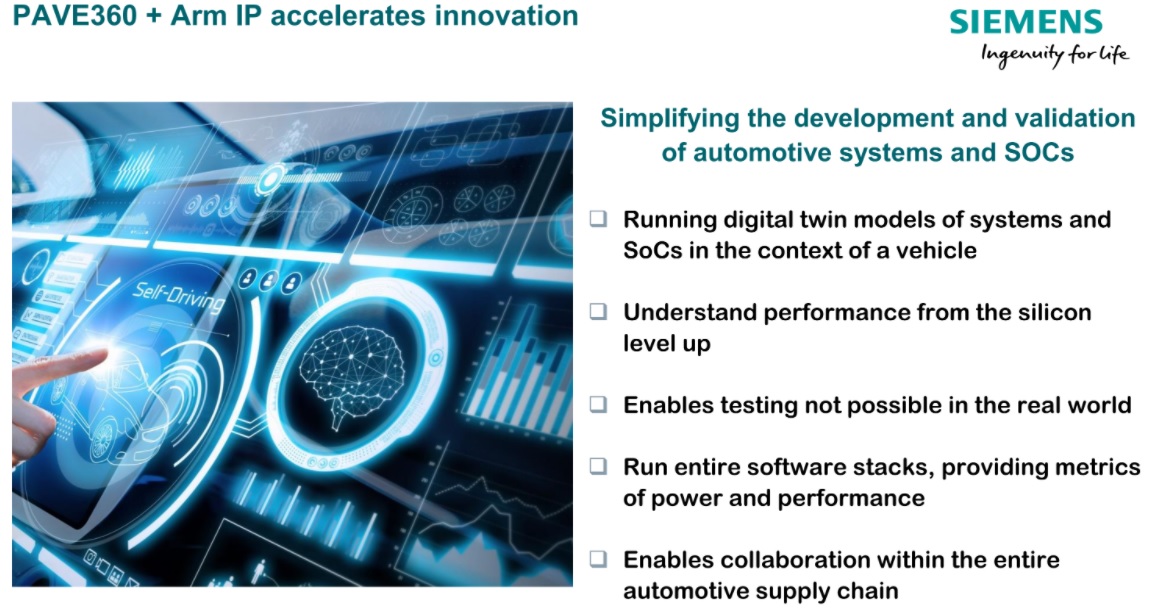
Siemens today announced a partnership with Arm to “accelerate the future of mobility by redefining design capabilities for complex electronic systems”. I spent time with David Fritz to understand what this really means. You may remember David from our webinar PAVE360: Of SoCs, Digital Twins, and Validating Autonomous Vehicle Behavior. David is the Global Technology Manager for Autonomous and ADAS at Siemens. But first some cut and paste from the press release which is better than most:
“Siemens’ PAVE360™ digital twin environment, featuring Arm IP, applies high-fidelity modeling techniques from sensors and ICs to vehicle dynamics and the environment within which a vehicle operates. Using Arm IP, including Arm Automotive Enhanced (AE) products with functional safety support, digital twin models can run entire software stacks providing early metrics of power and performance while operating in the context of a high-fidelity model of the vehicle and its environment, helping deliver a new future of mobility.
Using Siemens’ PAVE360 with Arm automotive IP, automakers and suppliers can simulate and verify sub-system and system on chip (SoC) designs, and better understand how they perform within a vehicle design from the silicon level up, long before the vehicle is built. Arm’s automotive IP is helping to democratize the ability to create safety-enabled silicon, bringing it within reach of the entire automotive supply chain. By rethinking IC design for the automotive industry, manufacturers can consolidate electronic control units (ECUs), leading to thousands of dollars in savings per vehicle by reducing the number of circuit boards and meters of wire within the vehicle design. This in turn reduces vehicle weight which can promote longer range electric vehicles.”
David and I went through a dozen slides illustrating the importance of validating complex systems of systems. David and I also talked about something I have been seeing on SemiWiki, the automotive supply chain is consolidating.
Many other competitive systems companies have already brought chip design in-house (Apple, Huawei, Google, Amazon, etc…) but for car companies it is more than just being competitive, it is all about safety and liability.
More than 100 people die in car accidents in the United States per day and many more are injured. When autonomous cars crash who will be held liable first? The car companies of course.
One more quote from the press release:
“In all we do at Siemens, our goal is to provide transportation companies and
suppliers the most comprehensive digital twin solutions, from the design and
development of semiconductors, to advanced manufacturing and deployment of vehicles and services within cities,” said Tony Hemmelgarn, president and CEO at Siemens Digital Industries Software. “Siemens believes collaboration with Arm is a win for the entire industry. Carmakers, their suppliers, and IC design companies all can benefit from the collaboration, new methodologies and insight now sparking new innovations.”
From the Arm 2020 Predictions Report:
Robots and Autonomous Vehicles Most Eagerly Awaited Future Tech
“In 2020, 5G will open up new levels of automotive connectivity enabling
carmakers to explore new infotainment experiences for passengers, including multimedia streaming and more responsive navigation. It’ll also open up benefits in vehicle-to-vehicle (V2V) and vehicle-to-infrastructure (V2I) communications, with potentially life-saving features such as detailed dashboard alerts that warn of unseen dangers ahead.”
Bottom line: Automotive companies MUST have complete PAVE360 control over their silicon in order to develop and validate better chips for the many autonomous car systems to insure safety and contain liability, absolutely.
Share this post via:





Comments
There are no comments yet.
You must register or log in to view/post comments.